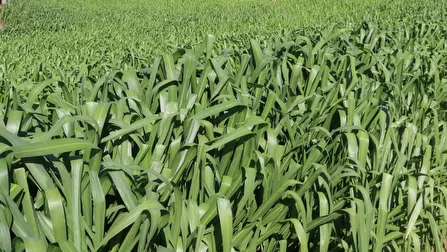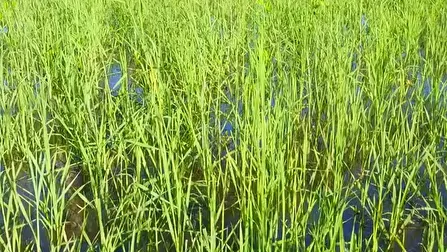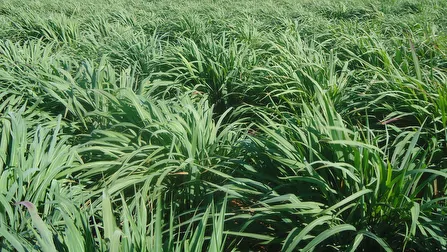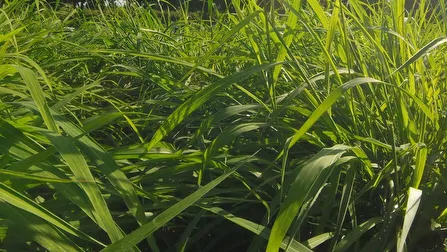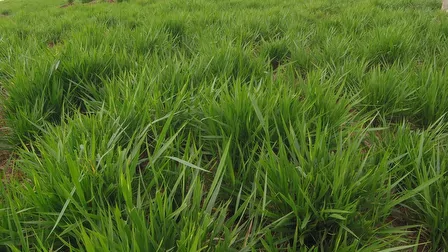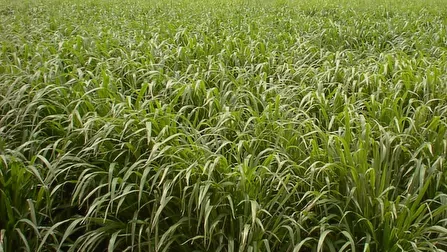Indicação
Indicada para solos de média fertilidade para bovinos de cria, recria e engorda e leite. Pode ser utilizada para pastejo direto e fenação. Boa tolerância a seca e climas áridos. Substituta direta da Brachiaria decumbens devido a sua maior produção de forragem e tolerância a cigarrinha das pastagens. Boa opção para Integração Lavoura-Pecuária.
Urochloa brizantha cv. MG 4
Brachiaria brizantha cv. MG 4
Média fertilidade, arenosos e ácidos
Pastejo direto, fenação e silagem
10 a 12 t/ha/ano de matéria seca (M.S.)
9 a 11%
De 1,00 a 1,50m
Boa
Boa
Alta
Média tolerância
Média
Perene
Utilização e Manejo
A MG 4 é indicada para solos de média fertilidade e mais arenosos, para pastejo direto e fenação para animais de cria, recria e engorda e produção leiteira. Pode ser utilizada também como opção de cobertura vegetal na Integração Lavoura-Pecuária. Tem boa tolerância a seca e climas áridos, devido ao desenvolvimento radicular profundo das suas plantas. O manejo da MG 4 em áreas de pastejo rotacionado deverá ocorrer a cada 25 a 30 dias ou quando a altura da planta atingir 60 a 80 cm durante a estação chuvosa e quente, e de 45 a 50 dias no inverno (frio e seco), em ambos os casos de 1 a 5 dias de pastejo. Em pastejo contínuo a altura de pastejo não deve ser menor que 15 a 20 cm. Este cultivar foi analisado em diversas condições de pastoreio, em diferentes tipos de manejo e com diferentes categorias animais. Em animais de cria e recria, nas diferentes épocas do ano, não se observaram quaisquer sintomas de intoxicação, mesmo quando a pastagem foi utilizada por longos períodos com animais jovens e vacas em lactação/gestação. Não foi observado também, qualquer tipo de sintomas referente a fotossensibilização, provocada pelo fungo Pithomyces chartarum. Em condições de engorda, o desempenho da MG 4 foi considerado bastante adequado, proporcionando ganhos de peso e lotações satisfatórias comparáveis aos rendimentos da decumbens.
Origem
Cultivar lançada comercialmente pela Matsuda em 1994 é utilizado em todo o Brasil e em diversos países latino americano. É o resultado de seleção realizada pela empresa para obter uma brizantha para solos ácidos, arenosos e de menor fertilidade. Este acesso foi introduzido da Austrália em 1975 e foi estabelecido inicialmente na região de Presidente Prudente–SP em pequenas áreas de pastagens, onde se destacou por sua produtividade, resistência à seca e capacidade de rebrota após o pastejo. A partir de 1988 se iniciaram os trabalhos sistemáticos de pesquisa com este genótipo, visando a sua liberação comercial.
Características Morfológicas
Gramínea de touceira vigorosa, com altura de 1,0 a 1,5m, apresenta rizomas horizontais curtos, duros e curvos, cobertas de escamas glabras de cor amarela ou arroxeadas. Produz grande quantidade de raízes profundas de cor branca amarelada e de consistência branda. Os talos são vigorosos, eretos ou semieretos, com escassa ramificação e de cor verde intenso. Os nós são proeminentes, glabros, de cor verde ou amarelo pálido e escasso enraizamento. As folhas são glabras, geralmente mais curtas que os entrenós, de cor verde intenso e de coloração arroxeada no extremo inferior. A lígula apresenta uma borda ciliada de cor branca, de aproximadamente 2 mm de comprimento. As folhas são linear-lanceoladas, arredondadas na base e em forma de quilha, de 16 a 40 cm de comprimento e 10 a 20 mm de largura e de cor verde intenso a claro; são glabras, com margens denticuladas e de cor arroxeada e branca. As nervuras são numerosas e finas, sendo a central de cor clara. Os entrenós são aplanados, de cor verde intenso e arroxeados no extremo superior. A inflorescência é uma panícula racemosa de 10 a 20 cm de longitude com 2 racemos unilaterais retos, em forma de espiga. Os racemos unilaterais são de 4 a 10 cm de comprimento. A raque é estriada de cor arroxeada e verde, com cílios laterais de 2 a 4 mm de comprimento. As espiguetas são oblongas ou oblongoelípticas de aproximadamente 6 mm de comprimento e 2,0 a 2,5 mm de largura, com pilosidade branca no ápice: as pontas geralmente são de coloração arroxeada. A cultivar MG4 pode ser diferenciada facilmente da cultivar Marandu pela associação obrigatória das seguintes características: a) Ausência de pêlos na porção apical dos entrenós; b) Bainhas glabras com margem denticuladas de coloração arroxeada e verde; c) Raque estriada de coloração arroxeada e verde.
Características Agronômicas
Possui média tolerância ao ataque da cigarrinha-daspastagens. Seu hábito de crescimento prostrado e a susceptibilidade ao herbicida glisosato fazem com que a MG 4 seja uma excelente opção para cobertura de solo em plantio direto de soja. Por sua melhor característica forrageira apresenta melhores resultados em áreas de ILPF quando comparada com a ruziziensis.

